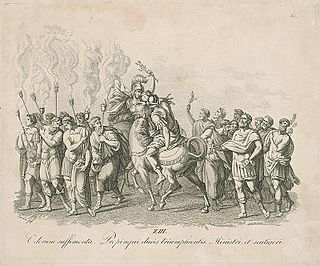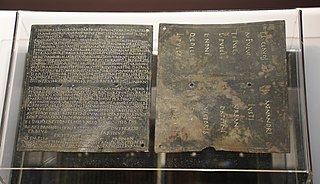Quintus Sosius Senecio was a Roman senator who was favored by the emperors Domitian and Trajan. As a result of this relationship, he was twice ordinary consul, an unusual and prestigious honor: first in 99, with Aulus Cornelius Palma Frontonianus as his colleague; and again in 107 as the colleague of Lucius Licinius Sura, who was himself consul for the third time.
Gaius Bruttius Praesens Lucius Fulvius Rusticus was an important Roman senator of the reigns of the emperors Trajan, Hadrian and Antoninus Pius. A friend of Pliny the Younger and Hadrian, he was twice consul, governed provinces, commanded armies and ended his career as Urban prefect of Rome. Bruttius’ life and career left few coherent traces in the literary record, but a number of inscriptions, including his complete cursus honorum, fills out the picture considerably.
Lucius Minicius Natalis was a Roman senator and military leader who occupied a number of offices in the imperial service. He was suffect consul in 106 with Quintus Licinius Silvanus Granianus Quadronius Proculus as his colleague. He is known entirely from inscriptions.
Lucius Catilius Severus Julianus Claudius Reginus was a Roman senator and general active during the reigns of Trajan and Hadrian. He was appointed consul twice: the first time in 110 CE with Gaius Erucianus Silo as his colleague; the second in the year 120 with the future emperor Antoninus Pius as his colleague. Catilius was also the step-great-grandfather of the emperor Marcus Aurelius.

Lucius Funisulanus Vettonianus was a Roman general and senator during the reigns of the Flavian emperors. He was suffect consul in the nundinium of September to October 78 with Quintus Corellius Rufus as his colleague.
Marcus Cornelius Nigrinus Curiatius Maternus was a Roman senator and general during the reign of Domitian. He was suffect consul during the nundinium of September to October AD 83 with Lucius Calventius Sextius Carminius Vetus. Although some experts consider him a rival with Trajan as heir apparent to the emperor Nerva, he is primarily known from inscriptions.
Quintus Glitius Atilius Agricola was a Roman senator and general who held several posts in the emperor's service. He was twice suffect consul: for the first time in AD 97 with Lucius Pomponius Sura as his colleague, and the second time in 103 when he replaced the emperor Trajan. He is the last known person to have held two suffect consulates. Agricola is known only through a large number of fragmentary inscriptions from Augusta Taurinorum, which appears to be his home town.
Lucius Julius Marinus Caecilius Simplex was a Roman senator who held several posts in the emperor's service. Simplex was then appointed suffect consul in late 101, with Lucius Arruntius Stella as his colleague. His career is primarily known through inscriptions.

Gaius Minicius Fundanus was a Roman senator who held several offices in the Emperor's service, and was an acquaintance of Pliny the Younger. He was suffect consul in the nundinium of May to August 107 AD with Titus Vettennius Severus as his colleague. Fundanus is best known as being the recipient of an edict from the emperor Hadrian about conducting trials of Christians in his province.
Sextus Subrius Dexter Cornelius Priscus was a Roman senator who held several imperial appointments during the reign of Trajan. He is best known for being an acquaintance of Pliny the Younger. Around the year 104 Cornelius Priscus was suffect consul for an as yet undetermined nundinium.
Quintus Fabius Postuminus was a Roman senator who was suffect consul in the nundinum of May to August 96 with Titus Prifernius as his colleague.

Lucius Valerius Propinquus was a Roman senator active in the second century AD. He was suffect consul who replaced the ordinary consul Marcus Annius Verus and was the colleague of the other ordinary consul, Gaius Eggius Ambibulus, for the remainder of the first nundinium of 126.

Lucius Vitrasius Flamininus was a Roman senator of the second century. He was suffect consul during 122 as the colleague of Tiberius Julius Candidus Capito. Flamininus is primarily known from inscriptions.
Marcus Pompeius Macrinus Neos Theophanes was a Roman senator of the second century who held several imperial appointments. He was suffect consul during the nundinium of September to December 115 with Titus Vibius Varus as his colleague. Older writers like Ronald Syme had dated his career some fifteen years earlier, but subsequent research confirmed a later date. Macrinus is primarily known from inscriptions.
Titus Calestrius Tiro Orbius Speratus was a Roman senator who held a series of offices in the emperor's service. He was suffect consul late in the year 122 as the colleague of Gaius Trebius Maximus.
Titus Julius Maximus Manlianus was a Roman senator active in the early second century who held a number of offices in the emperor's service. He was suffect consul for the nundinium July to September 112 as the colleague of Publius Stertinius Quartus. His complete name was Titus Julius Maximus Manlianus Brocchus Servilianus Aulus Quadronius [Verus?] Lucius Servilius Vatia Cassius Cam[ars].

Decimus Terentius Scaurianus was a Roman senator and general active in the late 1st and early 2nd centuries AD. He was suffect consul in either the year 102 or 104. He worked his way up through increasingly responsible positions. He commanded a legion from 96 to 98 and again during the Second Dacian War. After the war he was military governor of the newly conquered province from 106 to 111. He is known to have been decorated for his military service.
Lucius Antonius Albus was a Roman senator of the 2nd century AD who occupied a number of offices in the imperial service, as well as serving as suffect consul circa 132. Albus is best known for his tenure as proconsular governor of Asia, when, according to Aelius Aristides, a series of earthquakes struck western Asia Minor.
Marcus Acilius Priscus Egrilius Plarianus was a Roman senator, who held a number of imperial appointments during the reign of Emperor Hadrian. Mireille Corbier considers him the best known of the Egrilii Plariani, due to the large number of inscriptions referring to him.
Publius Cluvius Maximus Paullinus was a Roman senator, who held a number of imperial appointments during the reigns of Hadrian and Antoninus Pius. He was suffect consul during an undetermined nundinium between 139 and 143. He is known entirely from inscriptions.





